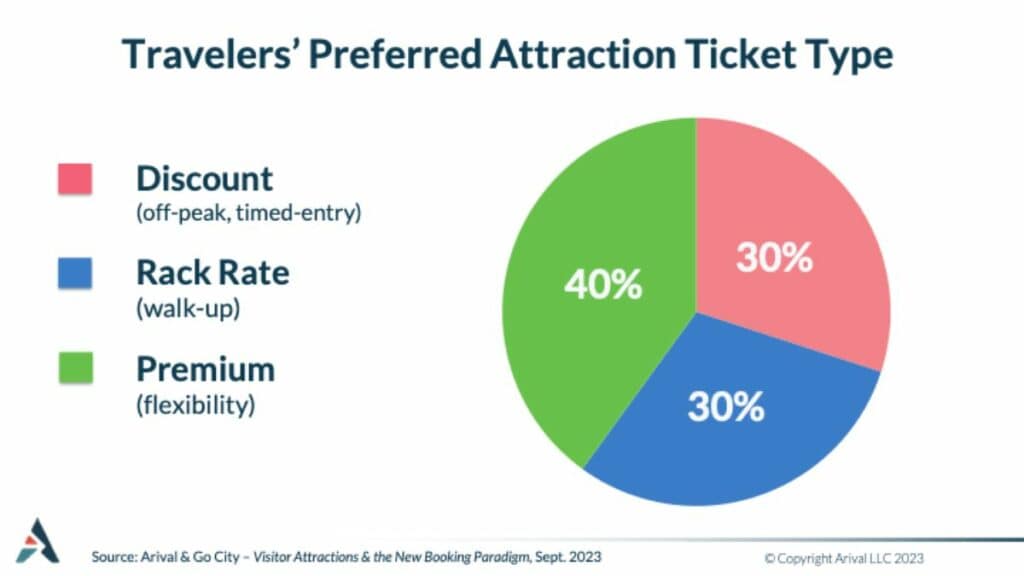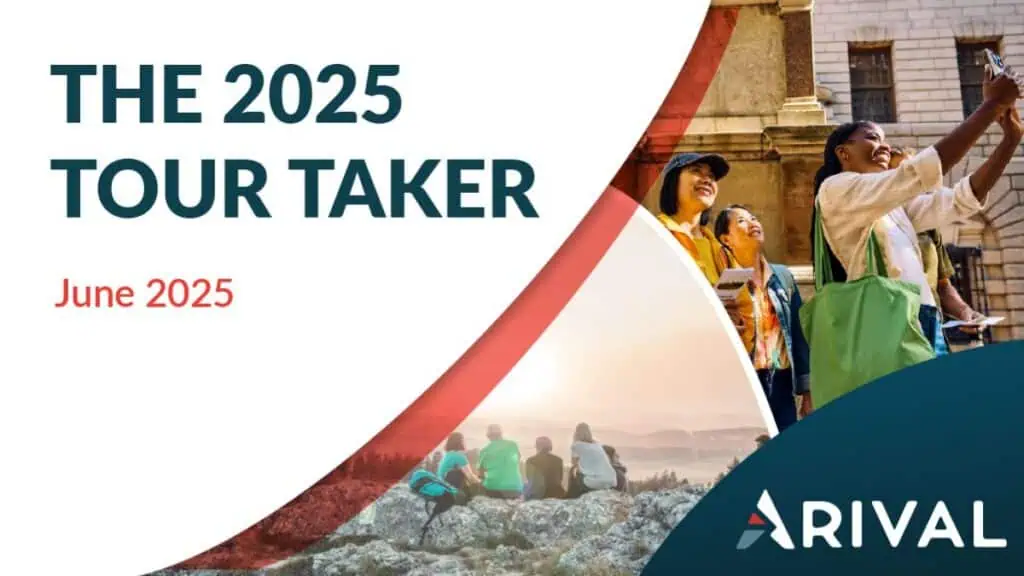What’s all the hype about variable and dynamic pricing? What do the terms actually mean? Should you be using one or the other (or both) in your pricing strategy? If so, which one is right for you?
One of the primary outcomes from the Attractions Forum at Arival 360 | Orlando was that dynamic and variable pricing are totally hot… and widely misunderstood. Although there is a lot of interest in both, particularly among attractions and large operators, there is also a lot of conflicting information around what you can do with these pricing strategies and how best to take advantage of them.
To bring some clarity to the confusion, we’ve put together this overview of variable and dynamic pricing for operators of tours, activities and attractions, including some top takeaways from the Attractions Forum with some attractions leading the way.
Defining the Terms
What exactly are we talking about here? First, let’s lay out some clear definitions. There are three basic types of pricing.
Static Pricing
Static pricing, also referred to as fixed pricing, means the price of the ticket does not change.
Variable Pricing
Variable Pricing is a rules-based approach whereby the price of the same ticket or product changes for different days of the week or times of day.
Dynamic Pricing
Dynamic Pricing refers to changing the price of a ticket based upon factors such as demand or weather.
27-29 April 2026
Insider Pro Access Members Save 20%
THE event of the year for the European in-destination experiences industry
Get Your Super Early Bird Ticket Today!|
Breaking Free from Fixed Pricing: Maximizing Revenue with Variable and Dynamic Pricing
The in-destination experiences industry has, for a very long time, worked on the premise of contracted rates, which typically means static or fixed pricing. Operators negotiate net prices with resellers (a net rate is the price at which an operator sells their products to a reseller, who then adds an agreed commission on top of that rate). Those prices are set for a fixed term, usually a year. The reseller has a guarantee that the prices won’t change during the term of the contract.
This has been standard operating procedure in our industry, but it also leaves money on the table. Sometimes consumers are willing to pay more.
For example, all operators tend to have a peak season, when demand is highest and when they tend to sell the most tickets. Those same operators also have shoulder seasons when demand is lower and they may struggle to fill seats. Charging the same price all year round ignores this very basic and predictable cycle.
Variable and dynamic pricing allow operators to adjust their pricing using a variety of criteria. In the previous example, an operator may increase their pricing during peak periods or days of the week to generate greater revenue. They may also reduce pricing during their shoulder seasons or weekdays when demand is lower to encourage more sales. Even in this most basic of scenarios, an annual contract with static pricing would limit an operator’s ability to make these price changes.
So what can operators and attractions do to move beyond static pricing and work effectively with resellers?
Let’s look a little more closely at variable and dynamic pricing, what the differences between them are, and how they are each being used in the experiences industry today.
Variable Pricing is All About Rules
The easiest way to think about variable pricing is “rules-based pricing.” If we look at the previous example of seasonal pricing, we can see that during the peak season the price goes up and during the shoulder season the price goes down.
In a variable pricing system, the operator would add a rule that says that from Day X to Day Y, the price of their tour increases by $Z or Z%. For the shoulder season rule, the operator may set from Day Y to Day Z, the price of their tour decreases by $X or X%.
In many systems, there are a number of criteria that can be used to adjust prices. The most common are:
- Date-based: Prices change during a given date range.
- Day of the week: Prices change based on specific days of the week. For example, Saturday prices are higher than Sunday prices.
- Capacity: Prices change when the capacity of a tour is within a certain range. For example, prices increase when there are between 1 and 5 seats remaining.
- Lead time: Prices change based on when the booking is made. For example, tickets purchased three weeks in advance are cheaper than tickets purchased the day of. An operator may also include last-minute discount tickets purchased within an hour of departure. Some systems support lead time in days, hours, or even minutes.
- Group size: Pricing may be adjusted based on the size of the group. For example, when the booking is for 3 or more people, the ticket price per person is $X, or decreases by $X or X%.
Variable Pricing Example
In addition, many systems allow you to cascade these rules together to create more complex pricing scenarios.
To illustrate how variable pricing can be implemented, consider a scenario where an operator introduces peak season Saturday pricing with a capacity restriction. Assuming a base ticket price of $100, the operator would establish the following rules:
- Date range (June 1 to September 30): Increase ticket prices by 10%, bringing them to $110.
- Day of the week (Saturday): Further increase ticket prices by 5%, resulting in a price of $115.50.
- Capacity restriction (less than 5 seats remaining): Apply an additional 5% increase, raising the ticket price to $121.28.
This cascading effect of rules demonstrates how variable pricing can dynamically adjust ticket prices based on various factors, optimizing revenue potential during peak periods. In this example, the ticket price could fluctuate between $110 and $121.28, depending on the booking time, chosen day of the week, and remaining ticket availability. Even within this simplified scenario, revenue per ticket could increase by 10-21%, highlighting the significance of variable pricing strategies.
As you can imagine, cascading rules-based systems can result in pricing changes that are unexpected. It is important that you understand the limitations of the variable pricing options provided by your reservation technology.
30 September – 3 October 2025
Insider Pro Access Members Save 20%
THE event of the year for solutions-focused In-Destination Experience creators and sellers
Get Your Spring Savings Ticket Today!
Dynamic Pricing is All About Boundaries
Dynamic pricing, unlike variable pricing, does not require operators to create explicit rules for pricing changes, but rather requires operators to set boundaries on price changes that the system makes on their behalf.
Dynamic pricing uses a variety of criteria to determine what the price should be regardless of things like date range, day of the week, capacity, etc. In most cases, dynamic pricing systems will use data aggregated across the system as well as other current and historical inputs to determine the best possible price at any given time.
Unlike variable pricing where you can predict what the pricing will be ahead of time based on the rules, dynamic pricing is real-time pricing. This means that it can change on a daily or even hourly basis based on a variety of factors.
Some of the factors that are used in dynamic pricing algorithms include:
- Historical booking data
- Passenger data (if available) – past shopping history
- Trend data – sales trends (predictive or quantitative)
- Weather – past and future weather
- Event data – Holiday dates, major events
- Traffic – Trends, predictive, and actual
- Competitive data – competitive pricing ranges
Other factors may be used as well depending on the dynamic pricing system and the specific operator. In all cases, however, the operator generally only sets pricing boundaries to prevent the dynamic pricing system from creating large swings in prices. For example, the operator may say the upper limit on prices is X and the lower limit is Y. The dynamic pricing system is then free to adjust pricing as required but will never go above or below the boundaries set by the operator.
Dynamic Pricing Example
A simple example of dynamic pricing is Uber’s surge pricing. When demand for rides increases dramatically for a specific pick-up location, the price per ride automatically increases. In this case, as demand increases, prices increase. This is automatically done by the system and doesn’t involve any human intervention from drivers or programmers at Uber.

Another example of dynamic pricing is airline pricing. How many times have you looked up airfares only to find that the price has changed the following day? Airlines have been using dynamic pricing to increase profits since the 1980s when airline pricing was deregulated. Since that time, they have invested considerable resources into earning as much out of every passenger as possible, in many cases to the passengers’ detriment.
But while Uber’s surge pricing and the airlines’ dynamic pricing strategies are often poorly received by customers, the Visitor Attractions & New Booking Paradigm Report from Arival & Go City shows that some customers are willing to pay more — as long as they get something they value in return, such as a premium experience or greater flexibility. As Go City’s CCO Judy Gauthier explained during the Attractions Forum at Arival 360 | Orlando, customer segmentation is the key:
Strategic Pricing Decisions for Tour and Attraction Operators: Evaluating Variable and Dynamic Pricing
Do Guests Prefer Variable or Dynamic Pricing?
Customers usually don’t know that variable or dynamic pricing is being used, except when pricing is clearly differentiated between the most popular and least popular times. Consumers have come to expect that prices will change under different conditions. Retail stores use coupons, sales, and promotions all the time to adjust their pricing and to take advantage of consumer buying patterns. The airline and hotel industries have used variable and dynamic pricing for decades to maximize customer spend and increase profits.
The fact that more tour and attraction operators do not use variable and dynamic pricing is a reflection of the state of the technology and ability of operators and resellers to support more complex pricing strategies. It does not necessarily mean travelers won’t accept it.
In fact, as Arival research has shown, many customers are quite willing to pay more for flexible tickets and a premium experience, while others are willing to accept the trade-off of more restricted tickets for a lower price.

Does My Booking System Support Variable or Dynamic Pricing?
Many booking systems or “res-techs” support some level of pricing control. Although some systems have advertised that they offer dynamic pricing, the reality is that in most if not all cases, what they are actually providing is a form of variable pricing. The easiest way to check is to see if your res-tech has a rules engine that supports price changes. If your system allows you to adjust pricing based on the aforementioned criteria, such as date range or day of the week, chances are very good that it supports variable pricing.
Dynamic pricing is much more challenging to support because it requires sophisticated algorithms that take into account each business’ unique booking patterns, consumer preferences, and other factors. Supporting that level of sophistication in an off-the-shelf res-tech platform would require an immense amount of data and resources. This is why there are companies who specialize in providing dynamic pricing engines that exist either on top of res-tech or in partnership with them.
Do OTAs and Resellers Support Variable or Dynamic Pricing?
The answer to questions like this in our industry is usually – ”it depends.” Many resellers can support limited forms of variable pricing, such as date-based rates. However, circumstances where a price could change during the contract term, such as dynamic pricing or a rules-based price variation, most online travel agencies (OTAs) and resellers do not support this capacity today. This would require that the connected distributor (OTA or reseller) check the price of a ticket in real-time.
Most connected resellers can only handle basic availability and reservation functions through their connections. However, OTAs and resellers are well aware of the growing demand for this capability, and many are investing in this capability. In addition, the non-profit association for connectivity standards OCTO will soon release its pricing capability in the OCTO specification.
27-29 April 2026
Insider Pro Access Members Save 20%
THE event of the year for the European in-destination experiences industry
Get Your Super Early Bird Ticket Today!|
Which is Right for You?
As the title of this article suggests, my recommendation is to try variable pricing before you jump into using dynamic pricing. It is simply easier to comprehend and is generally supported by most advanced reservation technology platforms. Variable pricing also provides you with the most amount of direct control and predictability over your pricing. Even if you use only a seasonal pricing rule to adjust your pricing twice a year, the impact on your direct revenues may be significant. For many operators and attractions, and especially smaller businesses, variable pricing may be enough.
For those operators who have successfully used variable pricing and have seen the impacts that price adjustments have had on their bottom lines, the switch to dynamic pricing may be a logical next step. Allowing a system to take past pricing changes, consumer behavior, and other factors into account when making less dramatic but highly optimized pricing changes, could have a significant impact on overall revenues.
As an example, the Florida Aquarium has seen a significant increase in per guest ticket pricing while maintaining a high level of customer satisfaction and increased visits, since they implemented their dynamic pricing strategy, as COO and EVP Strategic Initiatives, Andy Wood, shared during the Attractions Forum at Arival 360 | Orlando.
Keep in mind, every business is different and so your strategy moving forward should be reflective of your comfort with adjusting your pricing and your customer expectations. The bottom line is that there is money on the table that variable and dynamic pricing systems can help you collect. In many cases you already have access to some of these features, so don’t be afraid to take advantage of the features and benefits that your current system offers.
Dig Deeper into Variable Pricing and Dynamic Pricing
Witness the conversations about pricing strategies as well as other hot topics from the Attractions Forum, including AI, working with distribution, and “the content problem,” available on-demand now to Insider Pro Access members.
Also, learn more about key trends in visitor attractions, from variable and dynamic pricing to timed ticketing to attraction visitor and traveler behavior, in our Visitor Attractions & New Booking Paradigm Report based on a survey of 1,000 U.S. attraction travelers.
Finally, join us in March at Arival 360 | Berlin where we’ll assemble another panel of industry experts to continue the conversation on pricing strategies and more with the first Attractions Forum for Europe. We hope to see you there!
Become an Insider Pro Access member today and get access to the full library of Arival research, plus many other benefits such as free consulting sessions, special discounts and 20% off in-person events, starting from $179 per year.
Sign up to receive insights tailored for the in-destination industry as well as updates on Arival.

















